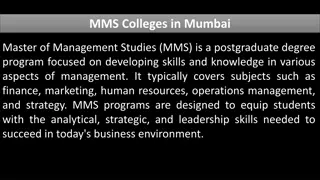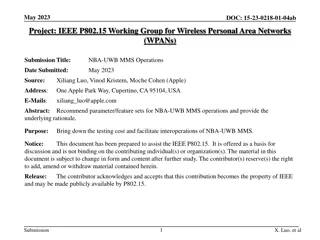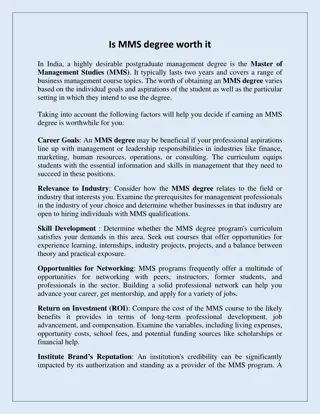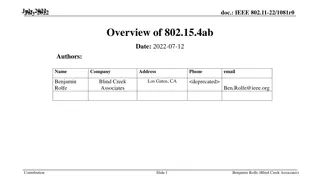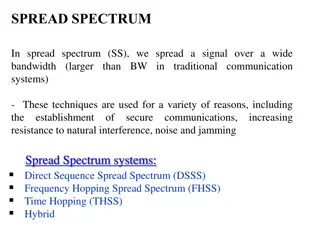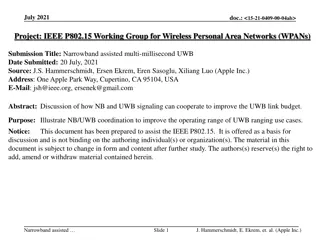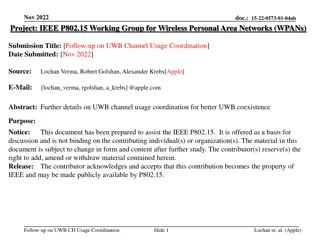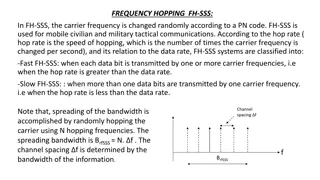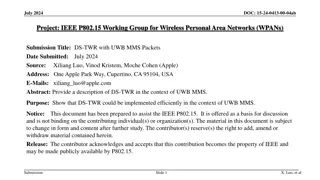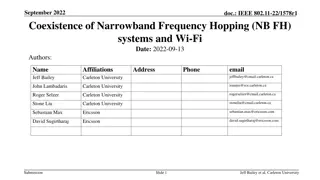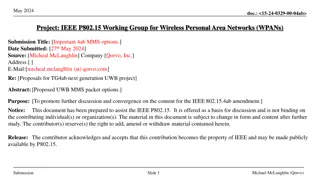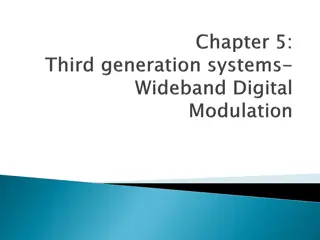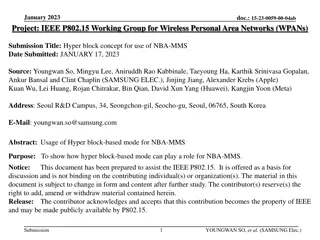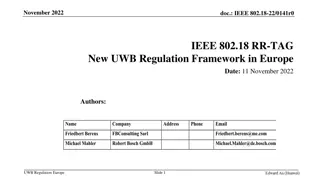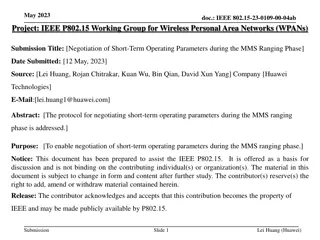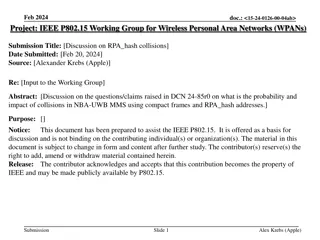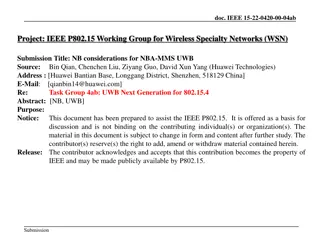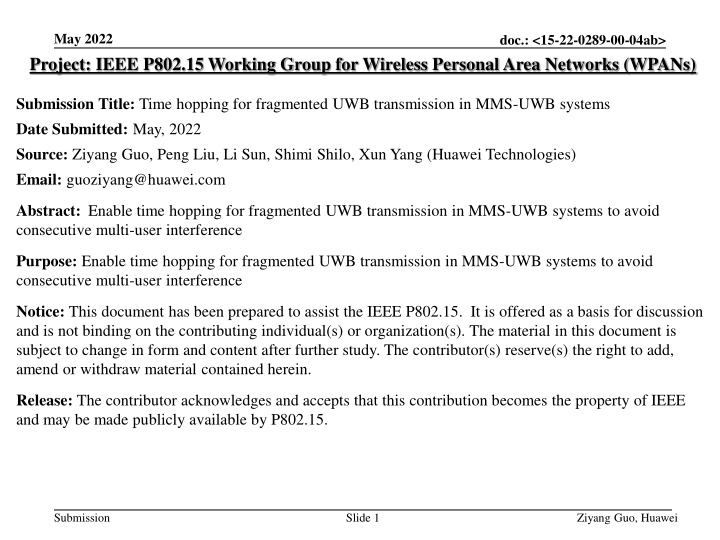
Advanced UWB Transmission Techniques for MMS Systems
Explore the implementation of time hopping for fragmented UWB transmission in MMS-UWB systems to mitigate consecutive multi-user interference. This submission aims to enhance interference mitigation techniques, coexistence improvements, and compatibility with newer devices. The document highlights the importance of safeguarding throughput while supporting various use cases and improving link budget and operational efficiency. Time hopping is proposed as a solution to avoid interference, along with advancements in accuracy, reliability, and power consumption. Additionally, this work focuses on improving data rates, supporting different protocols, and enhancing synchronization mechanisms for infrastructure.
Download Presentation

Please find below an Image/Link to download the presentation.
The content on the website is provided AS IS for your information and personal use only. It may not be sold, licensed, or shared on other websites without obtaining consent from the author. If you encounter any issues during the download, it is possible that the publisher has removed the file from their server.
You are allowed to download the files provided on this website for personal or commercial use, subject to the condition that they are used lawfully. All files are the property of their respective owners.
The content on the website is provided AS IS for your information and personal use only. It may not be sold, licensed, or shared on other websites without obtaining consent from the author.
E N D
Presentation Transcript
May 2022 Project: IEEE P802.15 Working Group for Wireless Personal Area Networks (WPANs) doc.: <15-22-0289-00-04ab> Submission Title: Time hopping for fragmented UWB transmission in MMS-UWB systems Date Submitted: May, 2022 Source: Ziyang Guo, Peng Liu, Li Sun, Shimi Shilo, Xun Yang (Huawei Technologies) Email: guoziyang@huawei.com Abstract: Enable time hopping for fragmented UWB transmission in MMS-UWB systems to avoid consecutive multi-user interference Purpose: Enable time hopping for fragmented UWB transmission in MMS-UWB systems to avoid consecutive multi-user interference Notice: This document has been prepared to assist the IEEE P802.15. It is offered as a basis for discussion and is not binding on the contributing individual(s) or organization(s). The material in this document is subject to change in form and content after further study. The contributor(s) reserve(s) the right to add, amend or withdraw material contained herein. Release: The contributor acknowledges and accepts that this contribution becomes the property of IEEE and may be made publicly available by P802.15. Submission Slide 1 Ziyang Guo, Huawei
May 2022 doc.: <15-22-0289-00-04ab> PAR Objective Proposed Solution (how addressed) Safeguards so that the high throughput data use cases will not cause significant disruption to low duty-cycle ranging use cases Interference mitigation techniques to support higher density and higher traffic use cases Other coexistence improvement Lower duty-cycle maybe helpful Interference mitigation technique to support higher density of fragmented UWB ranging pairs Backward compatibility with enhanced ranging capable devices (ERDEVs) Improved link budget and/or reduced air-time Additional channels and operating frequencies Improvements to accuracy / precision / reliability and interoperability for high-integrity ranging Reduced complexity and power consumption Hybrid operation with narrowband signaling to assist UWB Time-hopping for fragment transmission to avoid consecutive interferences Enhanced native discovery and connection setup mechanisms Sensing capabilities to support presence detection and environment mapping Low-power low-latency streaming Higher data-rate streaming allowing at least 50 Mbit/s of throughput Support for peer-to-peer, peer-to-multi-peer, and station-to- infrastructure protocols Infrastructure synchronization mechanisms Submission Slide 2 Ziyang Guo, Huawei
May 2022 doc.: <15-22-0289-00-04ab> MMS-UWB (Recap) 1ms 1ms Frag N Frag 1 Frag 2 Frag 3 Poll 1 2 3 N t/ms DATA Res Time and Freq Sync Improve ~10*log10N dB link budget by segmenting ranging preamble into N fragments spanning N milliseconds [1, 2] Interference issues with respect to wideband need to be discussed Submission Slide 3 Ziyang Guo, Huawei
May 2022 doc.: <15-22-0289-00-04ab> MMS-UWB Interference Issues Cat A 1ms 1ms Frag N SYNC Packet Frag 3 Frag 1 Frag 2 1 2 3 N t/ms Time and Freq Sync Interference from other UWB transmission e.g., other ranging pair, other data transmission pair Cat A: interference between MMS-UWB and other high-PRF data transmissions, e.g., 802.15.4z, or other high-duty cycle UWB activities [3] Interference from other UWB transmissions may lead to wrong ToA estimation of the fragments, see details in our previous submission [4] Interference to other UWB transmissions may also degrade their performances, e.g., packet dropout rate or ToA estimation error, depending on their operating scenarios, e.g., data transmission or ranging Submission Slide 4 Ziyang Guo, Huawei
May 2022 doc.: <15-22-0289-00-04ab> MMS-UWB Interference Issues Cat B 1ms Frag 1 Frag N NB CH i 1st ranging pair Frag 2 Frag 3 Poll N 1 2 3 DAT A Res t/ms 1ms Frag N Frag 1 Frag 3 Frag 2 Poll NB CH j, j i N 2nd ranging pair 1 2 3 DAT A Res t/ms 1ms Frag 1 Frag N Frag 2 Poll Frag 3 NB CH j N 3rd ranging pair 1 2 3 DAT A Res t/ms Cat B: Interference between multiple non-coordinated MMS-UWB ranging pairs NBA-MMS-UWB example: Even if Poll packets of different UWB ranging pairs transmit successfully using different NB channels (e.g., the 1st and 2nd pairs) or at different time period (e.g., the 2nd and 3rd pairs), collisions of consecutive UWB fragments may happen in the worst case. Submission Slide 5 Ziyang Guo, Huawei
May 2022 doc.: <15-22-0289-00-04ab> Summary of Related Techniques Technique Method Principle Cat A Cat B Requirement Time reversal- based [5] Interference Detection Detect interference and discard bad ranging measurement Time reversal operation CCA [4] Interference avoidance Listen before talk/clear channel assessment before transmission CCA support Mirror channel [6-8] NB assisted Channel access on NB Extra NB transmission over a common channel during UWB ranging Time Hopping Interference mitigation Mitigate interference via randomization Hopping function Submission Slide 6 Ziyang Guo, Huawei
May 2022 doc.: <15-22-0289-00-04ab> Time Hopping for MMS-UWB 1ms 1ms Xms Xms Frag 1 Frag 2 Frag 3 Frag N Poll 1 2 N 3 t/ms DATA Res Slot 2 Slot 3 Slot M Slot 1 Time and Freq Sync Enlarge the 1ms to (1+X)ms Divide Xms into M slots, the UWB fragment hops within M slots Reduce to NBA-MMS-UWB [1,2] when X=0 Tradeoff between time consumption and collision rate Submission Slide 7 Ziyang Guo, Huawei
May 2022 doc.: <15-22-0289-00-04ab> Time Hopping Function 1ms 1ms Xms Xms Frag 1 Frag 2 Frag 3 Frag N Poll 1 2 N 3 t/ms DATA Res Slot 2 Slot 3 Slot M Slot 1 Time and Freq Sync Time hopping function is to generate pseudo-random sequence for each UWB ranging pair: The sequence needs to be known by both the initiator and the responder The sequences for different ranging pairs need to have good cross-correlation Reuse existing time hopping function in 15.4 or design new mechanism Submission Slide 8 Ziyang Guo, Huawei
May 2022 doc.: <15-22-0289-00-04ab> Time Hopping Function -- OPT #1 Time hopping function in IEEE 802.15.4a (section 15.3.2) adopts linear feedback shift register (LFSR) with polynomial ?15+ ? + 1 and initial state determined by the preamble code to generate pseudo-random sequence NBA-MMS-UWB example: Set the initial state of LFSR as a function of NB channel index (suppose frequency hopping in NB) such that different ranging pairs can generate different hopping sequences Submission Slide 9 Ziyang Guo, Huawei
May 2022 doc.: <15-22-0289-00-04ab> Time Hopping Function -- OPT #2 IEEE 802.15.4 (section 6.2.10) define a channel shuffle algorithm for channel hopping which generates pseudo-random sequence of channel index within the available channel set Generate SHUFFLE using LFSR with polynomial ?9+ ?5+ 1 and starting seed 255 CHANNELS is initially populated with the monotonically increasing set of available channels Swap the elements of CHANNELS accordingly to obtain the pseudo-random sequence Submission Slide 10 Ziyang Guo, Huawei
May 2022 doc.: <15-22-0289-00-04ab> Time Hopping Function -- OPT #2 Reuse this algorithm to generate time hopping sequence for different ranging pairs NBA-MMS-UWB example: set the starting seed of LFSR related to NB channel index when generating SHUFFLE; or initialize CHANNELS according to NB channel index Could easily enlarge the period of pseudo-random sequence using higher-order polynomials, e.g., ?10+ ?7+ 1 Submission Slide 11 Ziyang Guo, Huawei
May 2022 doc.: <15-22-0289-00-04ab> Example of NBA-MMS-UWB with Time Hopping Suppose that frequency hopping is used in NB [1, 2] to avoid deep fading and interference from other technologies coexisting in the same band Initial value of time hopping function could be determined by NB channel index so that different UWB systems use different sequences with low cross- correlation Initial value of time hopping function could be determined by NB channel index NB ch m 1ms 1ms 1ms NB ch n M slots M slots M slots NB ch j NB ch k N B N B N B N B t(ms) Slot N Slot 1 Slot 2 Submission Slide 12 Ziyang Guo, Huawei
May 2022 doc.: <15-22-0289-00-04ab> Benefits of Time Hopping in Cat B Considered scenario: Number of pairs = 4, Number of UWB fragments = 32 Evaluate the worst-case performance with and without time hopping The worst-case number of collisions for different number of time slots is shown in the Table The proposed time hopping scheme for MMS-UWB reduce the number of collisions significantly The number of collisions decrease as the number of time slots increase Worst-case number of collisions Number of time slots OPT#1 OPT#2 No time hopping 4 10 10 8 6 6 32 16 4 3 32 3 2 *For ranging pair k, the initial states of LFSR is N*NB_Ch(k) + offset, N is the number of UWB fragment, offset is the optimal value among 1000 random search Submission Slide 13 Ziyang Guo, Huawei
May 2022 Systematic Benefits of Time Hopping in Cat B doc.: <15-22-0289-00-04ab> Considered Scenario: Number of pairs = 4, Number of UWB fragments = 32 Simulation Settings Descriptions Fragment Duration ~128us Evaluate the ranging performance with and without time hopping Peak PRF = 31.20MHz Mean PRF = 16.10MHz; Symbol duration = 993.59ns Random sequence like STS Fragment Settings Each pair adopts the proposed time hopping scheme and T1 to T4 are randomly selected in 0- 1ms to simulate the starting time of different ranging pairs Preamble symbol repetition 128 Channel model CM3 Office LOS 1ms 1ms 1ms M slots M slots M slots T1 Ranging pair 1 t(ms) M slots 1ms 1ms 1ms M slots M slots T4 Ranging pair 4 t(ms) Submission Slide 14 Ziyang Guo, Huawei
May 2022 Systematic Benefits of Time Hopping in Cat B doc.: <15-22-0289-00-04ab> Ranging error(m) Ranging error(m) Ranging error(m) Compared with no hopping [1,2], the proposed time hopping scheme can significantly reduce the probability of large ranging error, i.e., reduce consecutive collision significantly The ranging performance when using time hopping becomes better as the number of time slots (M) increases A larger number of time slots may lead to larger latency, which reflects the trade off between ranging latency and ranging accuracy The number of time slots M can be adjusted according to the interference Submission Slide 15 Ziyang Guo, Huawei
May 2022 doc.: <15-22-0289-00-04ab> Summary Non-coordinated multi-user interference issue is highlighted for MMS-UWB Time hopping scheme is proposed to mitigate the consecutive interference for fragmented UWB transmission The proposed time hopping scheme can work together with other interference detection/avoidance approaches, e.g., the time-reversal based approach [5] and CCA based approach [4] Time hopping function considerations: OPT #1 Reuse existing 802.15.4a (section 15.3.2) hopping function (Preferred) OPT #2 Reuse existing 802.15.4 (section 6.2.10) hopping function (Preferred) OPT #3 Newly designed time hopping function, but takes time and performance gain is not clear Example of time hopping in NBA-MMS-UWB is provided, in which the initial value of LFSR could be determined by NB channel index Submission Slide 16 Ziyang Guo, Huawei
May 2022 doc.: <15-22-0289-00-04ab> References 1. 15-21-0605-00-04ab-nba-mms-uwb-mac-considerations, Y. Liu et al. 2. 15-22-0080-00-04ab-nba-mms-uwb-mac-followup, Y. Liu et al. 3. 15-22-0242-00-04ab-review-of-uwb-coex-contributions, S Yang et al. 4. 15-22-0150-01-04ab-channel-access-considerations-on-fragmented-uwb-format, P. Liu et al. 5. 15-22-0072-02-04ab-Interference-detection-for-high-integrity-ranging-in-UWB- systems, L. Sun et al. 6. 15-22-0276-02-04ab-details-of-nb-mirroring-channel, M. Lee et al. 7. 15-22-0065-00-04ab-pilot-nb-radio-for-assisting-uwb-channel-access, H. Li et al. 8. Proposal of NB PHY assisted CCA for UWB medium access, H. Li et al. Submission Slide 17 Ziyang Guo, Huawei


